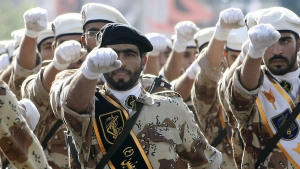SyriaIran to send a first contingent of 4,000 Iranian Revolutionary Guards to Syria
In preparation for the attack by Assad forces on rebel-held Aleppo, Iran announced it is sending a first contingent of 4,000 Iranian Revolutionary Guards to Syria to help the Syrian military. Iran’s goal is to help Assad capture Aleppo, and inflict a decisive defeat on the rebels, before U.S., and European, military aid begin to make a difference on the battlefield. Iran has also announced that it and Hezbollah are planning to open up a new “Syrian” front on the Golan Heights against Israel, and the presence of 4,000 Revolutionary Guards in Syria will allow Iran to do so. The United States responded by saying that 3,000 U.S. troops, a detachment of F-16s fighter jets, and batteries of Patriot missiles will remain in Jordan after the joint U.S.-Jordan military exercise they are currently participating in is over.

Iran sendinf 400 troops to Syria to assist Assad // Source: al-marsd.com
Four weeks ago, Hezbollah, the Lebanese Shi’a militia, began to move large forces into Syria, and coordinate these moves with the Syrian military. With about 3,500 Hezbollah fighters in place, the Assad government began the attack on al Qusayr, a rebel-held city located on the Syria-Lebanon border north of Damascus. After two weeks of relentless bombardment and ground fighting, the city fell to government forces in what must be regarded as a major defeat for the anti-government rebels.
The capture of the city and the area around it allows Assad to maintain a land corridor from Damascus to the Alawite enclave in northwest Syria, and to the cities of Homs and Hama, and easy land access to the Shi’a areas in the northeast parts of the Beqqa Valley in Lebanon.
There has been a growing criticism of Hezbollah in Lebanon for joining the battle in Syria, with critics charging that the organization is merely a tool of Iranian policies, not a genuine Lebanese force. Hezbollah, however, presented its decision to join the battle on behalf of the Assad regime as a move necessary to the future survival of Hezbollah, and thus its ability to continue in leading the cause of the “resistance” (that is, the resistance to Israel and the United States).
The battle for Syria will not be determined in al Qusayr, however, but in Aleppo, Syria’s commercial hub. The Assad regime has been amassing its forces near the city, which has been controlled by rebel forces for more than a year now.
Hezbollah fighters, however, will not participate in that battle. Having helped secure al Qusayr for the regime – at a price of about 400 of its fighters killed in the fighting — Hezbollah is pulling its forces back into Lebanon. It appears that Hassan Nasrallah, Hezbollah leader, understood that it is one thing to send his fighters to battle in Syria right across the border in al Qusayr, and it is another thing to send them to Aleppo, 400 miles to the north.
In addition, Saudi Arabia and Qatar have been arming Sunni militias in Lebanon, preparing them to take on Hezbollah, and Nasrallah needs his fighters back home to defend the Shi’a areas from the coming Sunni attacks.
The Assad forces will receive help from another source. The Independent on Sunday reports that Iran has decided to send a first contingent of 4,000 Iranian Revolutionary Guards to Syria to replace the withdrawing Hezbollah fighters, and support Assad’s forces as they prepare to attack Aleppo.
The Iranian decision has been made in anticipation of the U.S. decision, announced last Thursday, to provide military assistance to the rebels. The U.S. is planning initially to send only light arms, and the United Kingdom and France will not begin to provide military aid to the rebels before August.
Iran must thus have concluded it can help Assad capture Aleppo before the U.S. military supplies, let alone those coming for Europe, would make any difference on the ground.
In addition to helping Assad capture Aleppo and, thus, inflict a heavy defeat on the cause of the rebels, Iran has announced that it and Hezbollah are planning to open up a new “Syrian” front on the Golan Heights against Israel.
The presence of 4,000 Revolutionary Guards in Syria will allow Iran to do so.
The United States has responded by announcing that 3,000 U.S. soldiers, a detachment of F-16s fighter jets, and batteries of Patriot air-defense missiles will remain in Jordan to bolster Jordanian security and, analyst say, be ready to impose a no-fly zone over Syria if a decision is made to do so. The New York Times reports that 8,000 U.S. soldiers are currently in Jordan, taking part in a joint U.S.-Jordan military exercise. Some 5,000 of them will come home when the exercise is over, but the rest, together with the planes and missiles, will stay behind.
